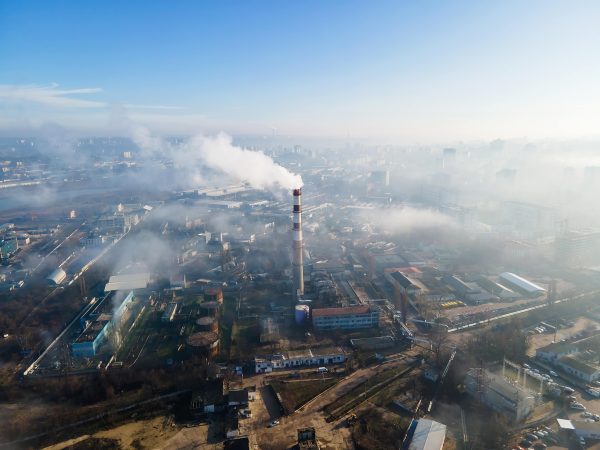
In the face of an increasingly urgent climate crisis, the concept of net zero emissions is in every (business) mouth. Net zero emissions refer to the state of achieving a balance between the greenhouse gases emitted and those removed from the atmosphere, thereby neutralizing the overall impact on the climate.
The window of opportunity to avert catastrophic climate change is rapidly closing. The Intergovernmental Panel on Climate Change (IPCC)’s latest report warns that we have just eight years to halve global greenhouse gas emissions to reach a 50% chance of limiting warming to 1.5 degrees Celsius, the threshold beyond which the impacts of climate change become significantly more severe. Achieving net zero emissions by 2024 is not just a business goal; it’s a necessity to safeguard our planet and its inhabitants.
While individual actions are important, companies play a bigger role in greenhouse gas emissions. The 100 largest corporations in the world are responsible for about 71% of global emissions. This means that companies have a huge responsibility to step up and take action to address climate change.
The UN’s Race to Zero initiative, a global movement aiming to achieve net zero emissions by 2050, has set 2024 as a crucial milestone for companies to significantly reduce their emissions and demonstrate their commitment to a sustainable future.
In this blog post, we’ll explore the practical strategies and actionable steps that companies can take to achieve net zero emissions in 2024. We’ll explore various industries, from manufacturing and energy to retail and transportation, and highlight specific case studies of companies that are leading the way.
Understanding the Challenges Behind Net Zero Emissions
Net-zero emissions refer to the state of balancing greenhouse gas emissions produced with those removed from the atmosphere. This balance neutralizes the overall impact on climate change. Achieving net-zero requires a concerted effort to drastically reduce emissions from various sectors, while simultaneously implementing methods to capture and store carbon dioxide.

Balancing Emissions and the Role of Carbon Capture
The challenge lies in achieving this balance while maintaining economic growth and ensuring energy security. Tackling emissions from industries like manufacturing, energy production, and transportation is crucial. Simultaneously, carbon capture and storage (CCS) technologies play a vital role in removing carbon dioxide from the atmosphere, providing a crucial pathway to net zero.
Businesses can significantly impact the environment through their operations, supply chains, and marketing efforts. Here are some of the most polluting aspects of a business:
- Websites & Digital tools: While websites may seem intangible, they generate significant waste, contributing to climate change and other environmental challenges. For example, websites rely on data centers to store and process user data. These data centers are massive energy consumers, often powered by fossil fuels like coal and natural gas. The energy consumption of data centers is a major contributor to global emissions.
- Supply Chain: The process of acquiring raw materials, manufacturing products, and delivering them to consumers can generate a significant amount of emissions. For example, the fashion industry is responsible for a large portion of global greenhouse gas emissions, with the production of a pair of jeans releasing an average of 3,300 liters of water and 21.3 kilograms of carbon dioxide.
- Transportation: Businesses often transport goods over long distances, which can generate a lot of emissions. For example, the transportation sector is responsible for 20% of global greenhouse gas emissions, with trucks accounting for about 60% of the total.
- Waste Generation: Businesses generate a lot of waste, including packaging, food scraps, and electronic waste. This waste can end up in landfills, which can pollute the environment and release harmful greenhouse gases.
- Deforestation: Businesses often clear land for their operations, which can lead to deforestation and the loss of biodiversity. For example, the palm oil industry is a major driver of deforestation, as it requires vast areas of land to grow palm trees.
Global Initiatives and Agreements Fostering Net Zero Goals
The international community has recognized the urgency of addressing climate change and has enacted several initiatives and agreements to promote net zero goals. These include:
- Paris Agreement (2015): This landmark agreement aims to limit global warming to well below 2 degrees Celsius, preferably to 1.5 degrees Celsius, compared to pre-industrial levels. It sets a target of reaching net-zero emissions by mid-century.
- Race to Zero (2020): Launched by the UNFCCC (United Nations Framework Convention on Climate Change), this initiative brings together governments, businesses, cities, and investors to commit to achieving net zero emissions by 2050.

- International Energy Agency Net Zero Emissions by 2050 Scenario (2021): This comprehensive analysis outlines the pathways and actions required to achieve net-zero emissions across various sectors.
These initiatives and agreements provide a framework and momentum for governments, corporations, and individuals to collaborate in achieving net-zero emissions.
Benefits of Achieving Net Zero Emissions

Achieving net-zero emissions offers a multitude of tangible benefits for businesses. These benefits can be broadly categorized into three areas:
1. Positive Impact on Brand Reputation and Consumer Trust
In an era of growing environmental consciousness, consumers are seeking out brands that share their values and actively contribute to sustainability. Embracing net-zero emissions can significantly enhance your company’s brand reputation, boosting its appeal to environmentally-conscious consumers and attracting new business opportunities.
A survey revealed that a vast majority of consumers worldwide are willing to pay more for products from sustainable brands, demonstrating the growing demand for eco-conscious offerings. By demonstrating commitment to environmental causes, companies can foster stronger customer loyalty and cultivate a positive brand image.
2. Cost Savings through Energy Efficiency and Waste Reduction
Implementing strategies to reduce emissions often leads to ancillary benefits in the form of cost savings. Energy efficiency initiatives can lower energy consumption, translating into reduced energy bills. Waste reduction efforts can minimize disposal costs and free up valuable resources. Moreover, adopting sustainable practices can enhance operational efficiency, leading to overall cost savings.
For instance, switching to LED lighting can significantly reduce energy consumption, saving businesses money on electricity bills. Implementing recycling programs can minimize waste disposal costs and free up space in landfills. Additionally, optimizing supply chains and reducing product packaging can minimize transportation costs and eliminate unnecessary waste.
3. Compliance with Regulatory Requirements and Global Sustainability Standards
Governments worldwide are increasingly enacting stricter environmental regulations and establishing sustainability standards. Achieving net-zero emissions can help businesses comply with these requirements, avoiding potential fines and legal challenges. It also demonstrates a company’s proactive approach to environmental responsibility, aligning with the growing consensus on sustainability.
For example, the United States’ Corporate Average Fuel Economy (CAFE) standards aim to improve fuel efficiency and reduce greenhouse gas emissions from vehicles. Similarly, the European Union’s Emissions Trading System (ETS) sets limits on carbon emissions from industrial installations and power plants. By achieving net-zero emissions, businesses can ensure they are meeting or exceeding these regulatory requirements.
Strategies for Achieving Net Zero Emissions

Here’s a breakdown of the key strategies to consider:
Adopting Renewable Energy Sources
Sustainable energy sources like solar and wind power play a crucial role in reducing carbon emissions. Businesses can transition to these clean energy sources by:
- Investing in solar and wind power installations: Installing solar panels on their rooftops or partnering with solar farms can provide businesses with clean electricity directly.
- Transitioning to green power suppliers: Businesses can purchase electricity from renewable energy providers, ensuring their energy consumption is sourced from sustainable sources.
Improving Energy Efficiency
Reducing energy consumption is essential for lowering greenhouse gas emissions. Businesses can implement energy efficiency measures such as:
- Upgrading equipment and facilities: Replacing old, inefficient equipment with energy-efficient models can significantly reduce energy consumption.
- Implementing energy-efficient technologies: Smart thermostats, LED lighting, and energy management systems can further optimize energy usage.
Sustainable Supply Chain Management
Supply chains often account for a significant portion of a business’s overall emissions. Businesses can minimize emissions across their supply chains by:
- Assessing and reducing emissions across the supply chain: Conducting comprehensive audits to identify emission hotspots and implementing strategies to reduce them.
- Collaborating with sustainable partners: Partnering with suppliers committed to sustainability can ensure that the entire supply chain is contributing to emission reductions.
Carbon Offset Initiatives
Carbon offsetting involves investing in projects that reduce or capture carbon dioxide emissions. Businesses can offset their residual emissions through:
- Investing in projects that reduce or capture emissions: Supporting projects like renewable energy initiatives or afforestation can compensate for unavoidable emissions.
- Purchasing carbon credits: Purchasing carbon credits from certified emission reduction projects can help offset residual emissions.
- With a solution like Pathmonk Climate, you can automate the purchase of carbon credits. It provides a holistic approach that encompasses:
- Emissions tracking and reporting: Pathmonk Climate helps businesses accurately track and report their greenhouse gas emissions across their operations.
- Carbon footprint analysis: Pathmonk Climate analyzes the business’s carbon footprint, identifying areas for improvement and suggesting targeted mitigation strategies.
- Pathway to net-zero: Pathmonk Climate provides a customized pathway to net-zero, outlining specific initiatives and timelines for achieving emission reductions.
- Technology integration: Pathmonk Climate integrates seamlessly with existing business systems, enabling data-driven decision-making and continuous improvement.
- Expert guidance: Pathmonk Climate provides expert guidance and support to businesses throughout their net-zero journey.
Real Examples of Companies on a Journey to Net Zero Emissions

A lot of companies have embarked on ambitious journeys to achieve net-zero emissions, demonstrating that sustainability is not just a buzzword but a tangible goal within reach.
Here are a few examples of companies that are leading the way:
1. Microsoft
Microsoft has set a bold target of achieving net-zero carbon emissions across its entire business by 2030. The company has made significant progress towards this goal, reducing its greenhouse gas emissions by 83% since 2013. Microsoft is investing heavily in renewable energy, has committed to purchasing all its electricity from renewable sources by 2025, and is working to reduce emissions from its data centers.
2. IKEA
IKEA, the world’s largest furniture retailer, is committed to becoming a fully circular and climate-neutral business by 2030. The company has already made significant progress towards this goal, reducing its greenhouse gas emissions by 46% since 2016. IKEA is investing in renewable energy, using more sustainable materials in its products, and reducing waste.
3. Unilever
Unilever, a global consumer goods company, has set a goal of achieving net-zero emissions across its entire value chain by 2039. The company is investing in renewable energy, improving energy efficiency, and reducing waste. Unilever is also working to reduce deforestation and improve the livelihoods of farmers in its supply chain.
These companies have used a variety of strategies to reduce their emissions, including:
- Investing in renewable energy: Moving to renewable energy sources like solar and wind power can significantly reduce a company’s carbon footprint.
- Improving energy efficiency: Upgrading equipment, using smart thermostats and LED lighting, and implementing energy management systems can all help reduce energy consumption and emissions.
- Managing supply chains: Collaborating with suppliers to reduce emissions across the supply chain can have a significant impact on a company’s overall emissions footprint.
- Offsetting emissions: Investing in projects that reduce or capture carbon dioxide emissions can help companies balance their unavoidable emissions.
These brands are demonstrating that it is possible for businesses to achieve net-zero emissions and that sustainability can be a driver of innovation and growth. By following their strategies and lessons learned, other businesses can also embark on their own net-zero journeys and contribute to a sustainable future.
Lessons Learned
Here are the main lessons you should keep from this article if you want to start your own journey to net-zero emissions:
- Set ambitious goals: Setting clear and ambitious goals is essential for driving progress towards net-zero emissions.
- Take a holistic approach: Addressing emissions across all aspects of a business is necessary to achieve net-zero emissions.
- Collaborate with stakeholders: Engaging with employees, customers, suppliers, and policymakers can help businesses achieve net-zero emissions more effectively.
- Measure and track progress: Regularly tracking emissions and measuring progress towards net-zero goals is crucial for ensuring success.
- Continuously improve: Businesses must be committed to continuous improvement to adapt to changing technologies and challenges.





